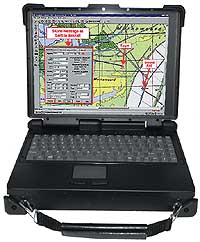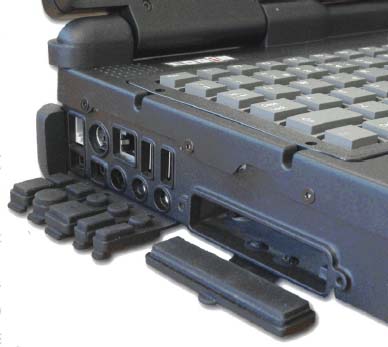|
Amrel Rocky RT7/RK7
Ruggedized notebook computer with various options
(by Conrad H. Blickenstorfer)
 Based in El Monte, California, AMREL (AMerican RELiance) has a long history of offering value-added applications in vertical markets. The Rocky line of ruggedized notebook computers was introduced in 1995 and has been updated, enhanced, and fine-tuned every since. AMREL was among the first to offer the full power, expansion, and convenience of a standard notebook in a ruggedized package.
Based in El Monte, California, AMREL (AMerican RELiance) has a long history of offering value-added applications in vertical markets. The Rocky line of ruggedized notebook computers was introduced in 1995 and has been updated, enhanced, and fine-tuned every since. AMREL was among the first to offer the full power, expansion, and convenience of a standard notebook in a ruggedized package.
A Rocky Matrix did well in one of our Pen Computing Magazine roundups with its combination of design, performance, and ruggedness. We also liked the ultra-sealed keyboard and individual rubber plugs.
AMREL uses a base notebook platform that is then customized and specialized for different markets. These days, AMREL offers its rugged notebook platform in federal/military, industrial, or medical versions. The military-spec models are the Rocky "Patriot" RT7-M and RK7-M, the industrial RT7-I model retains the "Rocky Unlimited" name, and the medical version, based on newer technology, is called the MRK8 60601 Medical Notebook.
 The industrial RT7-I and the military RT7-M are based on the same chassis, with the military model additionally certified to MIL-STD 461E electromagnetic emissions shielding and available with military connectors. Both have a 13.3-inch display with optional resistive touch screen. The RK7-M also has essentially the same specs, but uses a somewhat larger chassis to accommodate a 15-inch LCD. All models in the series have exceptional onboard connectivity which makes them suitable for a very wide range of applications.
The industrial RT7-I and the military RT7-M are based on the same chassis, with the military model additionally certified to MIL-STD 461E electromagnetic emissions shielding and available with military connectors. Both have a 13.3-inch display with optional resistive touch screen. The RK7-M also has essentially the same specs, but uses a somewhat larger chassis to accommodate a 15-inch LCD. All models in the series have exceptional onboard connectivity which makes them suitable for a very wide range of applications.
Like most other manufacturer of vertical market notebooks, AMREL has its own daylight viewable display technology. It's called the Alpha-Star SRL display and significantly increases screen image contrast and reduces reflective glare.
Amrel uses what it calls an "Advanced Modular Platform" to provide flexibility in configuring a machine to customer specifications. And AMREL provides a choice of two types of "dockunders," either a vertical or a horizontal model. Both provide port replication for easy mount and dismount in vehicles. With a choice of either two USB ports or two PCI slots, the horizontal dockunder offers multiple expansion capabilities for very flexible integration options.
|
|
|
|
Specifications
|
|
Added/updated
|
Updated 02/2008
|
|
Processor
|
Intel Pentium Dothan Processor
|
CPU Speed
|
1.5/1.6/1.8 GHz
|
Standard/Max RAM
|
512MB/2048MB DDR
|
Disk/drive
|
Removable 60-100GB HD + either FD or optical; optional Solid State HDD
|
Card slots
|
2 PC Card Type II, 2 internal mini PCI
|
Display type
|
"Alpha-Star" sunlight readable Anti-Reflective TFT
|
Display size/res
|
13.3 or 15.0-inch/1024x768 or 1400x1050
|
Digitizer/pens
|
Touchscreen option
|
Keyboard/scale
|
Integrated backlit 89 keys, 100%
|
Housing
|
Magnesium alloy casing
|
Operating Temp
|
-4 to 122 F
|
Sealing
|
IP54
|
Shock
|
MIL-STD 810F Certified (50 cm drop)
|
Size (WxHxD)
|
RT7: 12.3 x 9.7 x 2.5; RK7: 13.4 x 11.6 x 3.1
|
Weight
|
11/13.2 lbs. w/ CD-ROM and battery
|
Power
|
Removable 6,000 mAH Li-Ion (military connector option)
|
Interface
|
2 RS232, parallel, VGA, RJ11, RJ45, DVI, 2 USB 2.0, 2 IEEE1394, PS/2, audio in/out
|
Wireless
|
Options: 802.11, GPRS, CDMA, GPS
|
List price
|
Inquire
|
Contact
|
www.amrel.com
|
|
|
Definitions/Primers
|
|
What does "rugged" mean?
Rugged Specs Primer
Intrinsic Safety
NEMA Ratings
IP Rating
RFID
RFID vs. Bar Code
RFID viruses and
worms
|
|
Search
|
|
|
|



